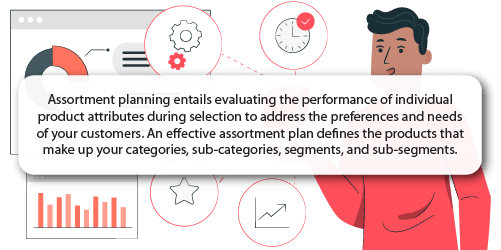Navigating the intricate landscape of retail demands a strategic compass, and at its core lies the assortment plan. But what embodies this pivotal concept? It's about curating a product assortment that resonates deeply with your consumers, driving sales, and bolstering brand loyalty. Effective assortment planning ensures your offerings are not just plentiful, but purposeful, aligning seamlessly with ever-evolving market demands and retail assortment customer desires.

Why is this meticulous crafting of a retail assortment so crucial? It's because, in a world inundated with options, consumers are not just seeking products; they're chasing experiences, narratives, and connections. A thoughtfully structured retail assortment becomes your story told through merchandise, echoing consumer aspirations and values. Get it right, and it transforms your stores into destinations, and casual shoppers into loyal advocates.
How do you transform their stores into such destinations? The answer lies in meticulous assortment planning. By weaving data analytics, consumer insights, and market trends together, you can formulate assortment plans that are not just responsive but proactive. Each product is a deliberate choice in your product assortment, anticipating consumer desires and setting the stage for an exploration of what truly defines an effective retail assortment plan.

Understand your customer profile
A deep understanding of the customer lies at the heart of any successful assortment plan. Before curating a range of products, you must delve deeply into your customer's psyche and preferences. This knowledge guides product selection and tailors the shopping experience to resonate authentically with your target audience.
We can break it down into market segmentation and consumer insights.
Market segmentation
Segmentation starts with customer demographics - age, gender, income, and location. For example, if you cater to teenagers in an urban setting, you'll have a vastly different assortment than if you cater to middle-aged consumers in suburbia.
Beyond demographics lie psychographics - your customer's values, attitudes, interests, and lifestyles. For example, a consumer segment deeply rooted in environmental consciousness will appreciate a range of sustainable products, while tech enthusiasts prefer the latest gadgets. Then there are buying behaviors; understanding when, why, and how often your consumers purchase can help you predict future buying patterns.
Tailoring assortment to specific market segments is not just strategic but imperative. It ensures that you stock products that resonate with and are relevant to your target audience, increasing the likelihood of purchase and fostering brand loyalty.
Consumer insights
In today's digital age, you have an arsenal of tools to gather insights about your consumers. Here, data analytics plays a pivotal role in assortment planning, helping you identify buying patterns, favorite product assortment categories, and even when your consumers are most likely to shop. This data-driven approach empowers you to anticipate demand and adjust your retail assortments proactively.
However, quantitative data is only half the story. To get a holistic view, you must also seek qualitative feedback. Surveys, focus groups, and one-on-one interviews can provide invaluable insights into the 'why' behind their purchases, revealing motivations, desires, and potential pain points. By combining quantitative data with qualitative feedback, you can craft an assortment plan that not only meets demand but also strikes a chord with the very soul of your customer base.

Analyze your past performance and current inventory
Understanding the present and predicting the future in retail hinges on insights gleaned from the past. An effective assortment plan is rooted in your past sales data and meticulous analysis of your current product assortment and inventory.
Sales data analysis
A deep dive into sales data allows you to spotlight the heroes and zeroes within your assortment. For example, your top-performing products or categories are more than just those with high sales figures. They're often the products that garner repeat purchases, pull traffic into stores, and generate positive word of mouth. Recognizing these top performers helps you to allocate resources more efficiently, ensuring that these star products are consistently available and promoted effectively.
Conversely, underperforming products in your retail assortment can drain your resources and eat into potential profits. However, it's crucial to identify these products and understand why they're underperforming within your assortment plan. Is it a pricing issue? Is it aligned with current market trends? Or is it simply not visible enough to the consumers? Analyzing the reasons behind weak sales can help you set up an action plan to boost their performance or validate a decision to discontinue them.
Inventory levels
Beyond sales, the health of your inventory is a determinant of its operational efficiency and profitability. Your stock turnover rates, which signify how often your products sell, are vital. High turnover rates indicate robust sales and efficient inventory management. In contrast, a low turnover can hint at overstocking or decreased demand, potentially leading to markdowns and reduced profits.
Also, be ever-vigilant about potential stock-outs - situations where demanded products aren't available. Not only do stock-outs result in lost sales, but they can also damage your reputation. On the flip side, overstock situations tie up capital and can lead to increased holding costs. Maintaining a balanced inventory enables you to be ready to cater to your customer's needs while maximizing your profitability.

Forecast future demand
The ability to predict tomorrow's demand determines today's success.
This foresight ensures that you remain relevant, competitive, and profitable. How do you forecast what your consumers will want in the future? Through a combination of trend analysis and demand forecasting techniques.
Trend analysis
Several tools and platforms offer predictive insights into future trends.
Platforms like Google Trends, fashion forecasting agencies, and data analytics software can help you understand emerging preferences in products, styles, and designs. Leveraging these tools ensures you stay ahead of the curve, always ready with products that cater to emerging market tastes.
Yet, while tools provide data, human insight remains indispensable.
You must actively engage with industry news and global events. Fashion weeks, tech conferences, and global happenings (like environmental movements or cultural festivals) can influence consumer preferences. Staying updated allows you to anticipate and adapt to shifts in consumer behavior and societal values.
Demand forecasting techniques
Forecasting isn't solely about following trends; it's a scientific endeavor that combines numbers and narrative. On the quantitative side, methods like time series analysis study past sales data to predict future sales patterns, and causal models try to identify specific factors (like marketing campaigns or economic indicators) that influence demand.
However, numbers don't capture the entire picture. Qualitative methods play a complementary role. Market research provides firsthand insights into consumer motivations, aspirations, and potential barriers to purchase.
Meanwhile, expert opinion from industry veterans or niche influencers can also shed light on emerging trends, potential market disruptions, or even global events that might influence demand.
By marrying the quantitative with the qualitative, you can craft a roadmap for the future to help you align your assortment strategy with anticipated market needs in your product assortment, ensuring you remain relevant and competitive.

Curate a balanced product mix
Retail success is as much about presenting the right blend of products in your product assortment as it is about understanding your customers and predicting future trends through effective assortment planning. A well-curated product mix ensures retailers address the diverse needs of their customers, leading to increased footfall, higher conversion rates, and sustained brand loyalty.
Product life cycle considerations
Every product has its journey - from launch to growth, maturity, and eventual decline. Manage this product life cycle to maximize profitability at each stage. Introducing new products stirs excitement, drawing in existing customers curious about the latest offerings and new customers attracted by fresh inventory.
Your core products are the backbone of your retail assortment. These are consistent best-sellers within your assortment plan, items that customers buy again and again. They demand prominent placement and consistent stock levels to meet ongoing demand demand in your product assortment. Conversely, as products age and lose their appeal, it becomes essential to phase out older products. That frees up shelf space for newer offerings and doesn’t tie up your capital in slow-moving stock.
Merchandise hierarchy
Understanding and setting up a merchandise hierarchy is crucial in shaping the optimal product mix. At the core are the essential products - staples that customers expect and define the brand. These might be white shirts in a clothing store, or standard grocery items in a supermarket. Surrounding these are seasonal products, which vary throughout the year based on holidays, seasons, or events.
Equally crucial is the mix of price points. Offering a variety ensures that you cater to a broad spectrum of your target market, from value-seekers to premium buyers. Furthermore, variety in types, styles, and categories prevents market saturation and provides options, keeping the shopping experience fresh and engaging for your customers.
By mastering this balancing act in your assortment plan, you can ensure your product mix is dynamic, appealing, and, most importantly, profitable.

Regularly review and adjust based on feedback
A static approach seldom reaps consistent rewards, especially in retail. Instead, success hinges on adaptability and responsiveness to change, making regular reviews and adjustments pivotal in your assortment plan. Feedback serves as the lighthouse guiding these course corrections in your product assortment.
Feedback mechanisms
Central to this feedback loop is the voice of the customer. Customer feedback, often gleaned from reviews, surveys, or direct interactions, provides invaluable insights into their needs, preferences, and pain points.
This feedback might point towards emerging product trends, highlight gaps in the product range, or spotlight areas for service improvement.
Yet, customers aren't the only valuable feedback source. Often overlooked, staff feedback is a treasure trove of insights. Employees, especially those on the sales floor, engage directly with customers daily. They observe firsthand what products fly off the shelves, which ones don't sell, and the common queries or shopper concerns. Their ground-level insights can often be more immediate and actionable than broader market research.
KPIs and performance metrics
Feedback isn't just qualitative; it’s equally quantifiable. You can lean heavily on key performance indicators (KPIs) to gauge the health and efficacy of your assortment plans and retail assortment.
Metrics like sales volumes and values indicate product popularity. Margins spotlight profitability, allowing you to see which products offer the best return on investment. Stock turn rates reflect inventory efficiency, ensuring your capital isn't tied up in unsold goods. Lastly, sell-through rates show the percentage of stock sold over a specific period, offering insights into product demand relative to supply.
Should these metrics flag concerns, it's imperative to act. You must be ready to make necessary adjustments, be it introducing new products, discontinuing underperformers, adjusting pricing strategies, or revamping marketing efforts.
Remember, an effective assortment plan is a living entity, evolving alongside market dynamics, consumer preferences, and real-time feedback in your product assortment, ensuring continuous alignment and profitability in your retail assortment.
Conclusion
Mastering assortment planning is the secret weapon of countless successful retailers. Ready to set your business apart and unlock strategies in product assortment that top retailers swear by? Download our retail assortment planning ebook now.


